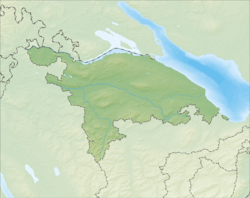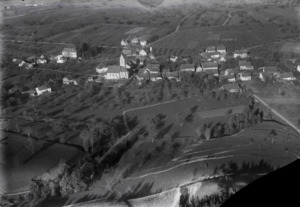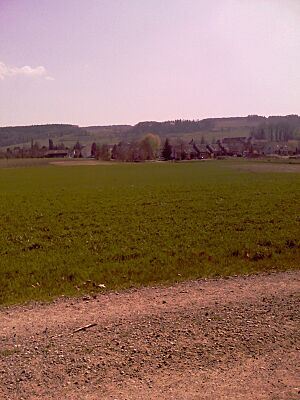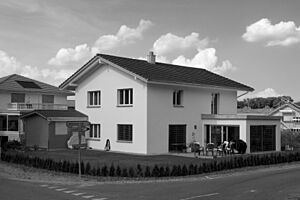Gachnang facts for kids
Quick facts for kids
Gachnang
|
||
|---|---|---|
 |
||
|
||
| Country | Switzerland | |
| Canton | Thurgau | |
| District | Frauenfeld | |
| Area | ||
| • Total | 9.74 km2 (3.76 sq mi) | |
| Elevation | 465 m (1,526 ft) | |
| Population
(Dec 2020 )
|
||
| • Total | 4,483 | |
| • Density | 460.27/km2 (1,192.1/sq mi) | |
| Postal code |
8547
|
|
| Surrounded by | Bertschikon bei Attikon (ZH), Ellikon an der Thur (ZH), Frauenfeld | |
Gachnang is a town, also called a municipality, in the Frauenfeld area of the canton of Thurgau in Switzerland. It's a place with a long history and beautiful landscapes.
Contents
History of Gachnang
Gachnang was first written about in the year 889. Back then, it was called Kachanang. People who live there traditionally called it Gochlingen in their local dialect.
Long, long ago, in an area called Egelsee, people found old items from the Pfyn culture. This shows that people lived here thousands of years ago! In 889, King Arnulf gave a special manor house (a large country house) in Gachnang to his follower, Diethelm. This house came with ten smaller huts for people who worked for him.
From the 11th century, Gachnang belonged to the Reichenau monastery. Important families, like the Lords of Gachnang, managed the village for powerful rulers. They lived in Alt-Gachnang Castle, which is now in ruins, or at the Meierhof Meiersberg. Later, in 1336, a family took the name "von Gachnang" and got the castle and its lands. In 1417, the Lords of Schinen took over. They built a new castle, Neu-Gachnang Castle, before the year 1500. Over the years, other important families and groups owned the village, including Einsiedeln Abbey. The Abbey had the right to make some local laws until 1798.
The main church area, or parish, of Gachnang has been around for a very long time, even before the year 1000. It included many villages in the Thurgau and Zurich areas. The church you see today was built before the 13th century. In 1528, the whole town changed to the Protestant Reformation religion. Later, the parish was divided, and a Catholic chapel built in 1587 became its own church.
For a long time, Gachnang was a farming village. It didn't grow much beyond its old church and castle areas. But since the mid-1900s, it has become a popular place for people to live. In 1998, several nearby villages like Kefikon, Islikon, Gerlikon, Niederwil, and Oberwil joined with Gachnang to form the municipality it is today.
Geography of Gachnang
Gachnang covers an area of about 9.72 square kilometers (about 3.75 square miles). A big part of this land, about 65%, is used for farming. Forests cover about 16.7% of the area. The rest of the land, about 17.9%, has buildings or roads. There are also small areas of rivers, lakes, or land that isn't used for anything.
Most of the built-up areas are industrial buildings, but there are also houses and roads. The forested land is mostly dense forests, with some orchards and small groups of trees. The farmland is mainly used for growing crops.
Gachnang is in the Frauenfeld district. It includes the main villages of Gachnang, Kefikon, Islikon, and Niederwil. It also has smaller settlements called hamlets, like Strass and Bethelhausen, and Oberwil with Rosenhuben.
People and Population
Gachnang has a population of about 3,500 people. Around 10.7% of the people living here are from other countries. Most people in Gachnang speak Swiss German. The next most common languages are Italian and Albanian.
In 2008, there were slightly more men (50.7%) than women (49.3%) living in Gachnang. The population changes each year due to births, deaths, and people moving in or out. In 2008, the total population of Gachnang grew by about 1.8%.
The people in Gachnang are of all ages. In 2009, about 11.6% of the population were children aged 0-9, and 13.4% were teenagers aged 10-19. Adults aged 20-59 made up about 58.4% of the population. Older adults, aged 60 and above, made up about 16.6% of the population.
In 2000, there were about 1,124 households in Gachnang, with an average of 2.5 people living in each. Most of the homes were single-family houses. Many people lived in families with children.
When it comes to voting, in the 2007 federal election, the most popular political party was the SVP. About 48.5% of people who could vote actually did vote in that election.
Here's how Gachnang's population has changed over time:
| year | population |
|---|---|
| 1850 | 1,456 |
| 1900 | 1,368 |
| 1950 | 1,694 |
| 1990 | 3,038 |
| 2000 | 2,906 |
Important Historical Sites
Gachnang has two important heritage sites that are recognized nationally. These are the Egelsee (a prehistoric settlement by the shore) and the old Greuterhof factory with its barn. The prehistoric settlement at Egelsee is so important that it's part of the Prehistoric Pile dwellings around the Alps, which is a UNESCO World Heritage Site. This means it's recognized globally for its special historical value!
Economy and Jobs
In 2007, Gachnang had a low unemployment rate of 1.16%, meaning most people who wanted jobs had them.
- About 98 people worked in the primary economic sector, which includes jobs like farming.
- Around 370 people worked in the secondary sector, which means jobs in manufacturing or construction.
- The largest group, 465 people, worked in the tertiary sector, which includes jobs in services like shops, offices, and healthcare.
Many people who live in Gachnang travel to other towns for work. In 2000, about 58.2% of residents worked outside Gachnang. However, 514 people came into Gachnang for work. Most people (53.9%) used a private car to get to work, while 13.8% used public transportation.
Religion in Gachnang
Based on a census from 2000:
- About 28.2% of the people were Roman Catholic.
- About 53.7% belonged to the Swiss Reformed Church (a Protestant church).
- Smaller numbers of people belonged to other Christian churches, the Orthodox Church, or Islam.
- About 7.57% of the population said they didn't belong to any church, or were agnostic or atheist.
Education and Schools
Switzerland is known for its good education system, and Gachnang is no exception. Many adults (79.5%) in Gachnang have completed higher education, like university or special colleges. Gachnang has its own primary school district.
In the 2008/2009 school year, there were 383 students in Gachnang's schools.
- There were 87 children in kindergarten.
- There were 154 children in the lower primary grades (ages 5-6).
- There were 142 children in the upper primary grades.
The average class size in primary school was about 21 students. A small number of students were not Swiss citizens or did not speak German as their first language.
Getting Around (Transport)
The Gachnang-Islikon railway station is a convenient stop for trains. It's part of the Zurich S-Bahn network, with services like S24 and S30 stopping there. This makes it easy for people to travel to and from Gachnang by train.
See also
 In Spanish: Gachnang para niños
In Spanish: Gachnang para niños












